Container Ships: Operations, Market, and Future Challenges Analysis
VerifiedAdded on 2020/05/28
|9
|1742
|105
Report
AI Summary
This report offers a comprehensive overview of container ships, detailing their operations, major areas of service, and key owners. It explores different charter party types and analyzes the current state of the freight market, including profitability and losses within the industry. The report also examines the future forecast for container ships, considering the challenges and opportunities in the face of evolving transport methods. The analysis covers important aspects such as the impact of air cargo, the decline in trade in certain regions, and the need for innovation to remain competitive. The report concludes with a summary of the key findings, emphasizing the importance of adapting to new market conditions and technologies.
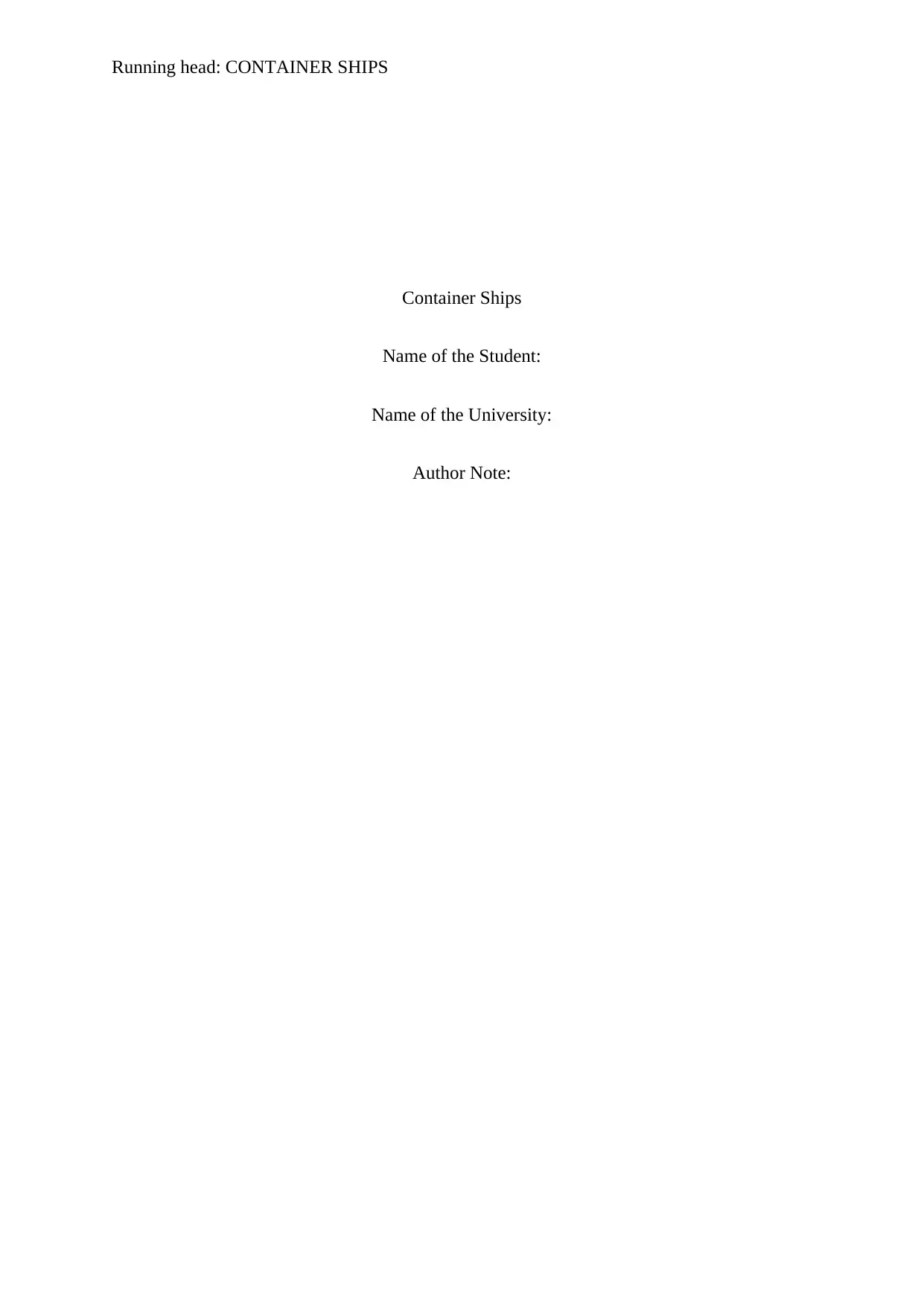
Running head: CONTAINER SHIPS
Container Ships
Name of the Student:
Name of the University:
Author Note:
Container Ships
Name of the Student:
Name of the University:
Author Note:
Paraphrase This Document
Need a fresh take? Get an instant paraphrase of this document with our AI Paraphraser
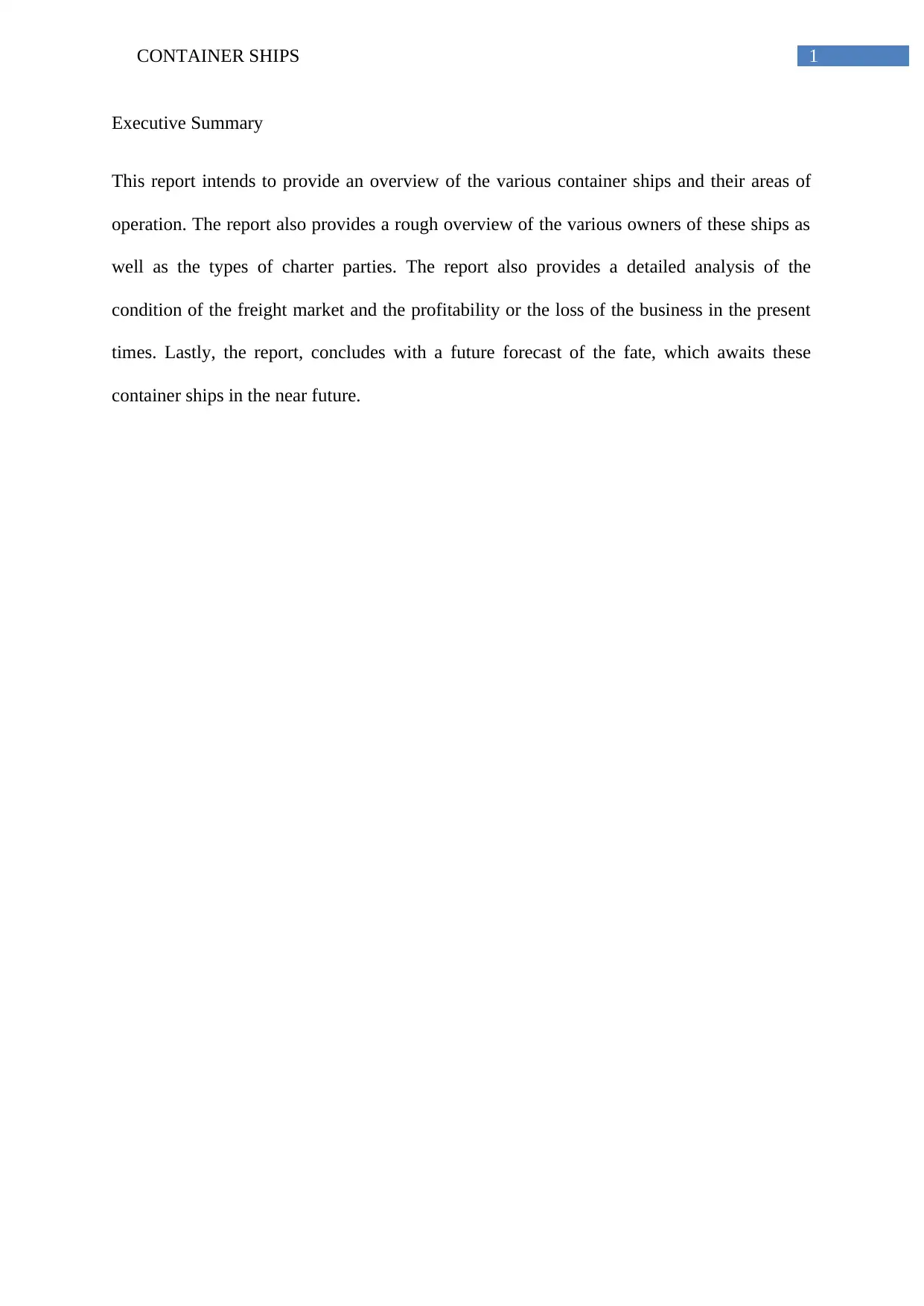
1CONTAINER SHIPS
Executive Summary
This report intends to provide an overview of the various container ships and their areas of
operation. The report also provides a rough overview of the various owners of these ships as
well as the types of charter parties. The report also provides a detailed analysis of the
condition of the freight market and the profitability or the loss of the business in the present
times. Lastly, the report, concludes with a future forecast of the fate, which awaits these
container ships in the near future.
Executive Summary
This report intends to provide an overview of the various container ships and their areas of
operation. The report also provides a rough overview of the various owners of these ships as
well as the types of charter parties. The report also provides a detailed analysis of the
condition of the freight market and the profitability or the loss of the business in the present
times. Lastly, the report, concludes with a future forecast of the fate, which awaits these
container ships in the near future.
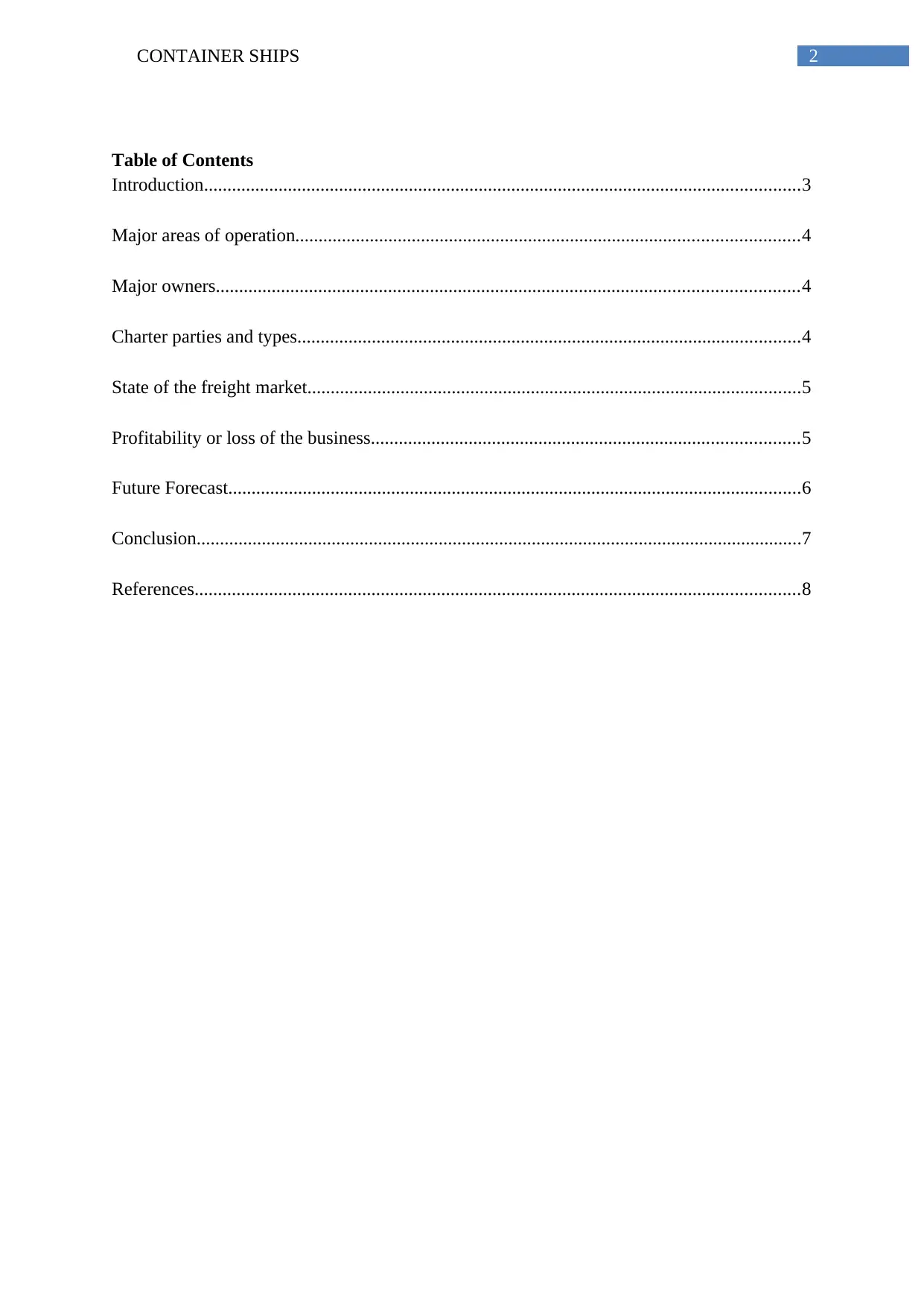
2CONTAINER SHIPS
Table of Contents
Introduction................................................................................................................................3
Major areas of operation............................................................................................................4
Major owners.............................................................................................................................4
Charter parties and types............................................................................................................4
State of the freight market..........................................................................................................5
Profitability or loss of the business............................................................................................5
Future Forecast...........................................................................................................................6
Conclusion..................................................................................................................................7
References..................................................................................................................................8
Table of Contents
Introduction................................................................................................................................3
Major areas of operation............................................................................................................4
Major owners.............................................................................................................................4
Charter parties and types............................................................................................................4
State of the freight market..........................................................................................................5
Profitability or loss of the business............................................................................................5
Future Forecast...........................................................................................................................6
Conclusion..................................................................................................................................7
References..................................................................................................................................8
⊘ This is a preview!⊘
Do you want full access?
Subscribe today to unlock all pages.

Trusted by 1+ million students worldwide
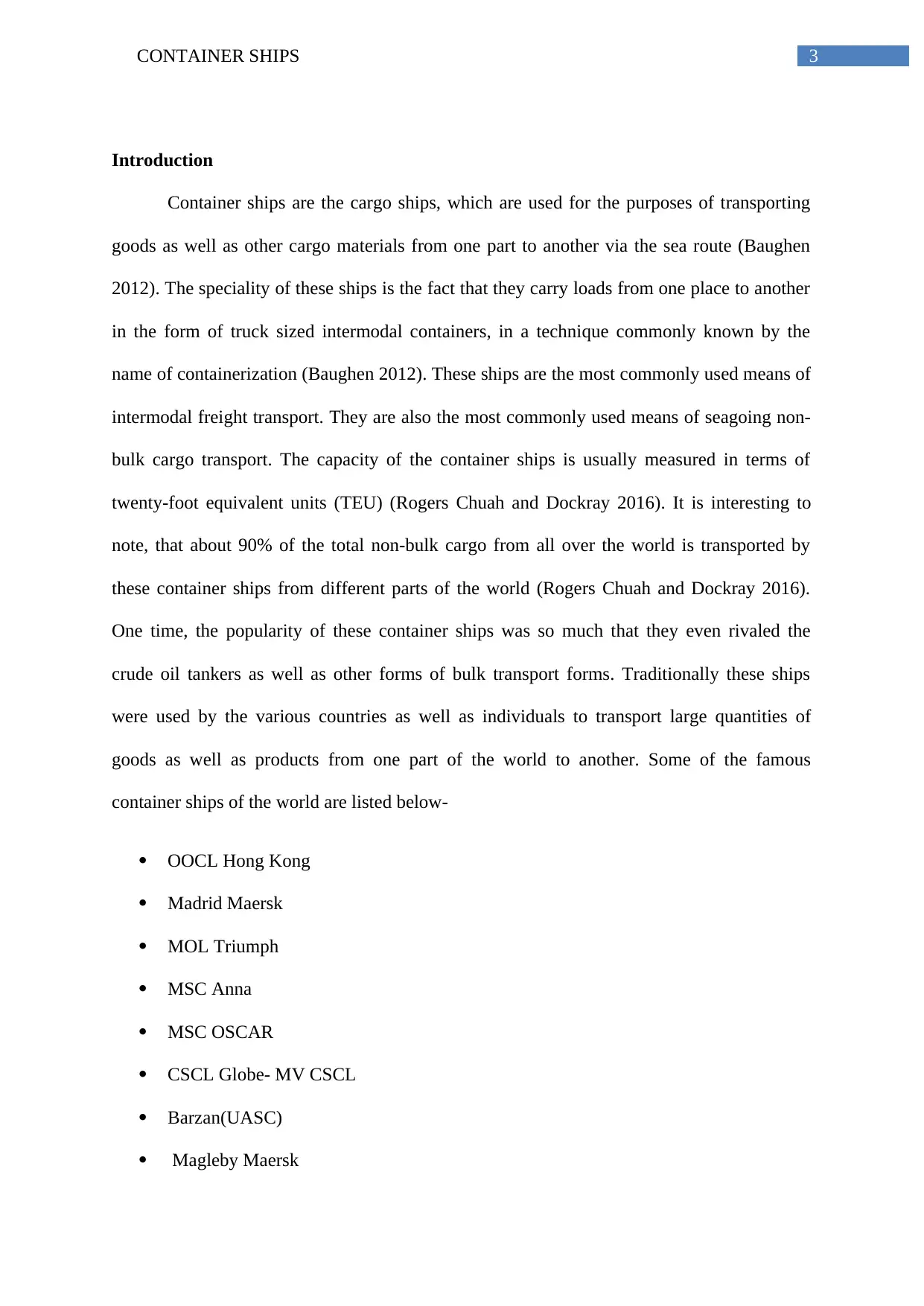
3CONTAINER SHIPS
Introduction
Container ships are the cargo ships, which are used for the purposes of transporting
goods as well as other cargo materials from one part to another via the sea route (Baughen
2012). The speciality of these ships is the fact that they carry loads from one place to another
in the form of truck sized intermodal containers, in a technique commonly known by the
name of containerization (Baughen 2012). These ships are the most commonly used means of
intermodal freight transport. They are also the most commonly used means of seagoing non-
bulk cargo transport. The capacity of the container ships is usually measured in terms of
twenty-foot equivalent units (TEU) (Rogers Chuah and Dockray 2016). It is interesting to
note, that about 90% of the total non-bulk cargo from all over the world is transported by
these container ships from different parts of the world (Rogers Chuah and Dockray 2016).
One time, the popularity of these container ships was so much that they even rivaled the
crude oil tankers as well as other forms of bulk transport forms. Traditionally these ships
were used by the various countries as well as individuals to transport large quantities of
goods as well as products from one part of the world to another. Some of the famous
container ships of the world are listed below-
OOCL Hong Kong
Madrid Maersk
MOL Triumph
MSC Anna
MSC OSCAR
CSCL Globe- MV CSCL
Barzan(UASC)
Magleby Maersk
Introduction
Container ships are the cargo ships, which are used for the purposes of transporting
goods as well as other cargo materials from one part to another via the sea route (Baughen
2012). The speciality of these ships is the fact that they carry loads from one place to another
in the form of truck sized intermodal containers, in a technique commonly known by the
name of containerization (Baughen 2012). These ships are the most commonly used means of
intermodal freight transport. They are also the most commonly used means of seagoing non-
bulk cargo transport. The capacity of the container ships is usually measured in terms of
twenty-foot equivalent units (TEU) (Rogers Chuah and Dockray 2016). It is interesting to
note, that about 90% of the total non-bulk cargo from all over the world is transported by
these container ships from different parts of the world (Rogers Chuah and Dockray 2016).
One time, the popularity of these container ships was so much that they even rivaled the
crude oil tankers as well as other forms of bulk transport forms. Traditionally these ships
were used by the various countries as well as individuals to transport large quantities of
goods as well as products from one part of the world to another. Some of the famous
container ships of the world are listed below-
OOCL Hong Kong
Madrid Maersk
MOL Triumph
MSC Anna
MSC OSCAR
CSCL Globe- MV CSCL
Barzan(UASC)
Magleby Maersk
Paraphrase This Document
Need a fresh take? Get an instant paraphrase of this document with our AI Paraphraser
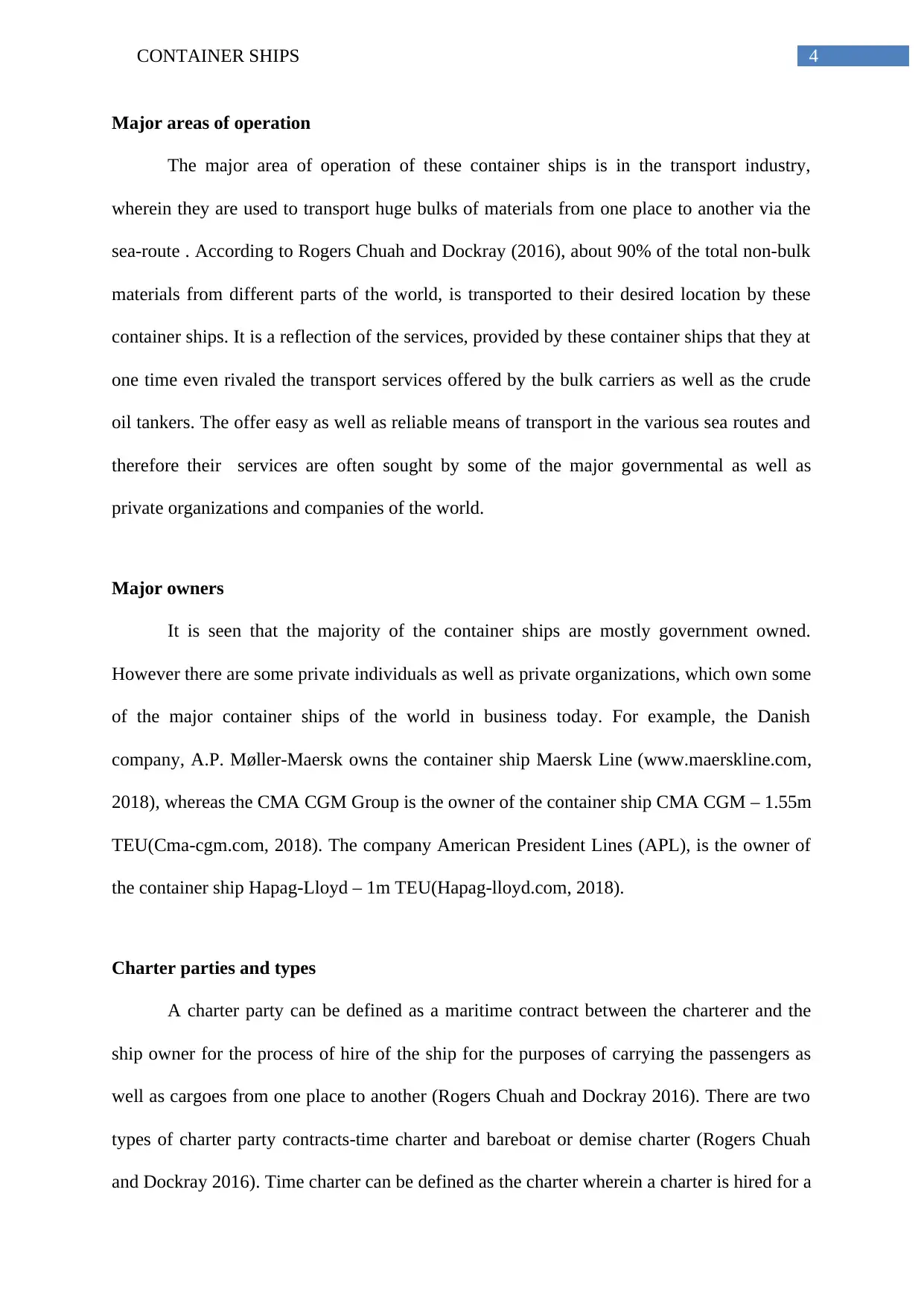
4CONTAINER SHIPS
Major areas of operation
The major area of operation of these container ships is in the transport industry,
wherein they are used to transport huge bulks of materials from one place to another via the
sea-route . According to Rogers Chuah and Dockray (2016), about 90% of the total non-bulk
materials from different parts of the world, is transported to their desired location by these
container ships. It is a reflection of the services, provided by these container ships that they at
one time even rivaled the transport services offered by the bulk carriers as well as the crude
oil tankers. The offer easy as well as reliable means of transport in the various sea routes and
therefore their services are often sought by some of the major governmental as well as
private organizations and companies of the world.
Major owners
It is seen that the majority of the container ships are mostly government owned.
However there are some private individuals as well as private organizations, which own some
of the major container ships of the world in business today. For example, the Danish
company, A.P. Møller-Maersk owns the container ship Maersk Line (www.maerskline.com,
2018), whereas the CMA CGM Group is the owner of the container ship CMA CGM – 1.55m
TEU(Cma-cgm.com, 2018). The company American President Lines (APL), is the owner of
the container ship Hapag-Lloyd – 1m TEU(Hapag-lloyd.com, 2018).
Charter parties and types
A charter party can be defined as a maritime contract between the charterer and the
ship owner for the process of hire of the ship for the purposes of carrying the passengers as
well as cargoes from one place to another (Rogers Chuah and Dockray 2016). There are two
types of charter party contracts-time charter and bareboat or demise charter (Rogers Chuah
and Dockray 2016). Time charter can be defined as the charter wherein a charter is hired for a
Major areas of operation
The major area of operation of these container ships is in the transport industry,
wherein they are used to transport huge bulks of materials from one place to another via the
sea-route . According to Rogers Chuah and Dockray (2016), about 90% of the total non-bulk
materials from different parts of the world, is transported to their desired location by these
container ships. It is a reflection of the services, provided by these container ships that they at
one time even rivaled the transport services offered by the bulk carriers as well as the crude
oil tankers. The offer easy as well as reliable means of transport in the various sea routes and
therefore their services are often sought by some of the major governmental as well as
private organizations and companies of the world.
Major owners
It is seen that the majority of the container ships are mostly government owned.
However there are some private individuals as well as private organizations, which own some
of the major container ships of the world in business today. For example, the Danish
company, A.P. Møller-Maersk owns the container ship Maersk Line (www.maerskline.com,
2018), whereas the CMA CGM Group is the owner of the container ship CMA CGM – 1.55m
TEU(Cma-cgm.com, 2018). The company American President Lines (APL), is the owner of
the container ship Hapag-Lloyd – 1m TEU(Hapag-lloyd.com, 2018).
Charter parties and types
A charter party can be defined as a maritime contract between the charterer and the
ship owner for the process of hire of the ship for the purposes of carrying the passengers as
well as cargoes from one place to another (Rogers Chuah and Dockray 2016). There are two
types of charter party contracts-time charter and bareboat or demise charter (Rogers Chuah
and Dockray 2016). Time charter can be defined as the charter wherein a charter is hired for a
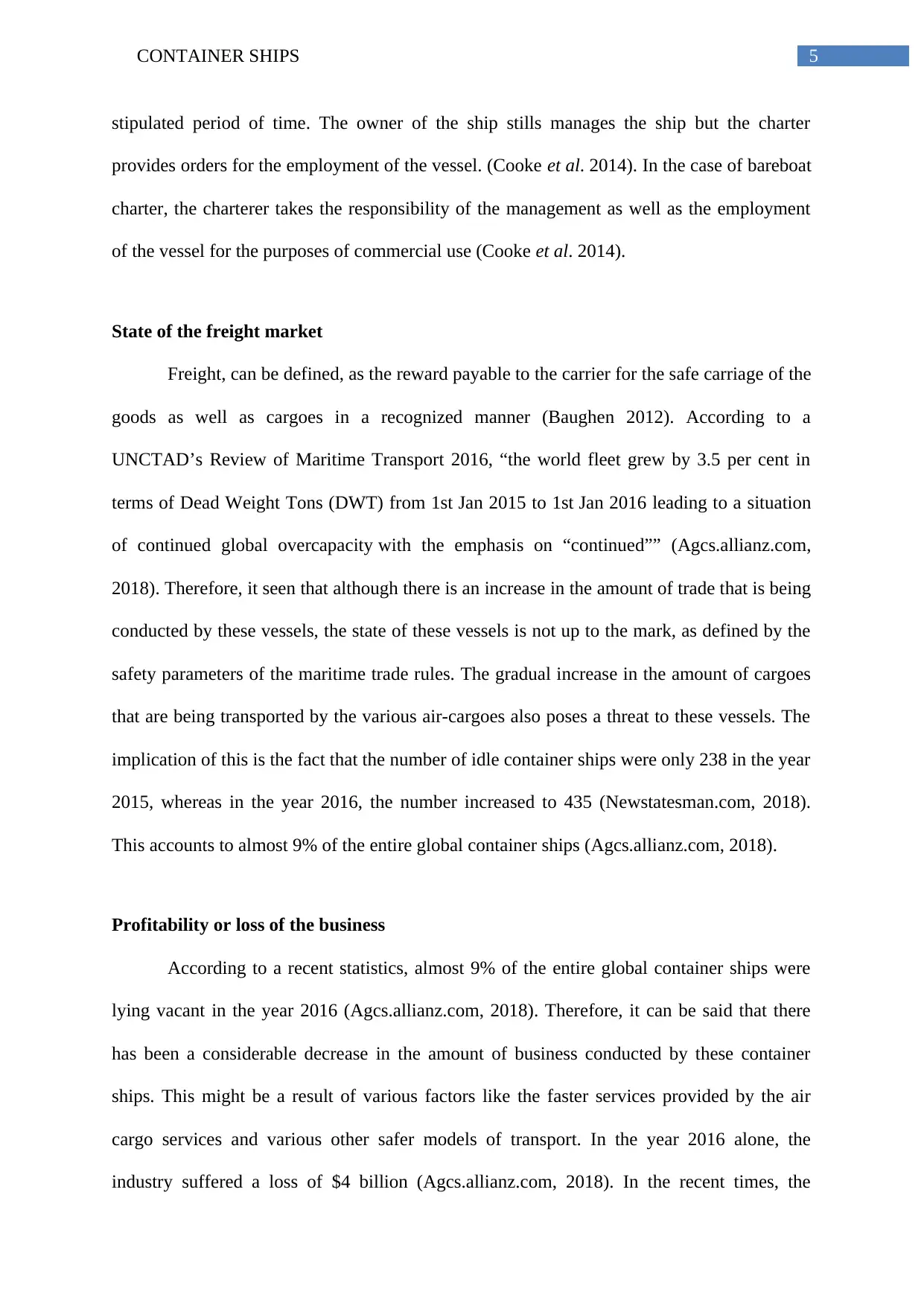
5CONTAINER SHIPS
stipulated period of time. The owner of the ship stills manages the ship but the charter
provides orders for the employment of the vessel. (Cooke et al. 2014). In the case of bareboat
charter, the charterer takes the responsibility of the management as well as the employment
of the vessel for the purposes of commercial use (Cooke et al. 2014).
State of the freight market
Freight, can be defined, as the reward payable to the carrier for the safe carriage of the
goods as well as cargoes in a recognized manner (Baughen 2012). According to a
UNCTAD’s Review of Maritime Transport 2016, “the world fleet grew by 3.5 per cent in
terms of Dead Weight Tons (DWT) from 1st Jan 2015 to 1st Jan 2016 leading to a situation
of continued global overcapacity with the emphasis on “continued”” (Agcs.allianz.com,
2018). Therefore, it seen that although there is an increase in the amount of trade that is being
conducted by these vessels, the state of these vessels is not up to the mark, as defined by the
safety parameters of the maritime trade rules. The gradual increase in the amount of cargoes
that are being transported by the various air-cargoes also poses a threat to these vessels. The
implication of this is the fact that the number of idle container ships were only 238 in the year
2015, whereas in the year 2016, the number increased to 435 (Newstatesman.com, 2018).
This accounts to almost 9% of the entire global container ships (Agcs.allianz.com, 2018).
Profitability or loss of the business
According to a recent statistics, almost 9% of the entire global container ships were
lying vacant in the year 2016 (Agcs.allianz.com, 2018). Therefore, it can be said that there
has been a considerable decrease in the amount of business conducted by these container
ships. This might be a result of various factors like the faster services provided by the air
cargo services and various other safer models of transport. In the year 2016 alone, the
industry suffered a loss of $4 billion (Agcs.allianz.com, 2018). In the recent times, the
stipulated period of time. The owner of the ship stills manages the ship but the charter
provides orders for the employment of the vessel. (Cooke et al. 2014). In the case of bareboat
charter, the charterer takes the responsibility of the management as well as the employment
of the vessel for the purposes of commercial use (Cooke et al. 2014).
State of the freight market
Freight, can be defined, as the reward payable to the carrier for the safe carriage of the
goods as well as cargoes in a recognized manner (Baughen 2012). According to a
UNCTAD’s Review of Maritime Transport 2016, “the world fleet grew by 3.5 per cent in
terms of Dead Weight Tons (DWT) from 1st Jan 2015 to 1st Jan 2016 leading to a situation
of continued global overcapacity with the emphasis on “continued”” (Agcs.allianz.com,
2018). Therefore, it seen that although there is an increase in the amount of trade that is being
conducted by these vessels, the state of these vessels is not up to the mark, as defined by the
safety parameters of the maritime trade rules. The gradual increase in the amount of cargoes
that are being transported by the various air-cargoes also poses a threat to these vessels. The
implication of this is the fact that the number of idle container ships were only 238 in the year
2015, whereas in the year 2016, the number increased to 435 (Newstatesman.com, 2018).
This accounts to almost 9% of the entire global container ships (Agcs.allianz.com, 2018).
Profitability or loss of the business
According to a recent statistics, almost 9% of the entire global container ships were
lying vacant in the year 2016 (Agcs.allianz.com, 2018). Therefore, it can be said that there
has been a considerable decrease in the amount of business conducted by these container
ships. This might be a result of various factors like the faster services provided by the air
cargo services and various other safer models of transport. In the year 2016 alone, the
industry suffered a loss of $4 billion (Agcs.allianz.com, 2018). In the recent times, the
⊘ This is a preview!⊘
Do you want full access?
Subscribe today to unlock all pages.

Trusted by 1+ million students worldwide
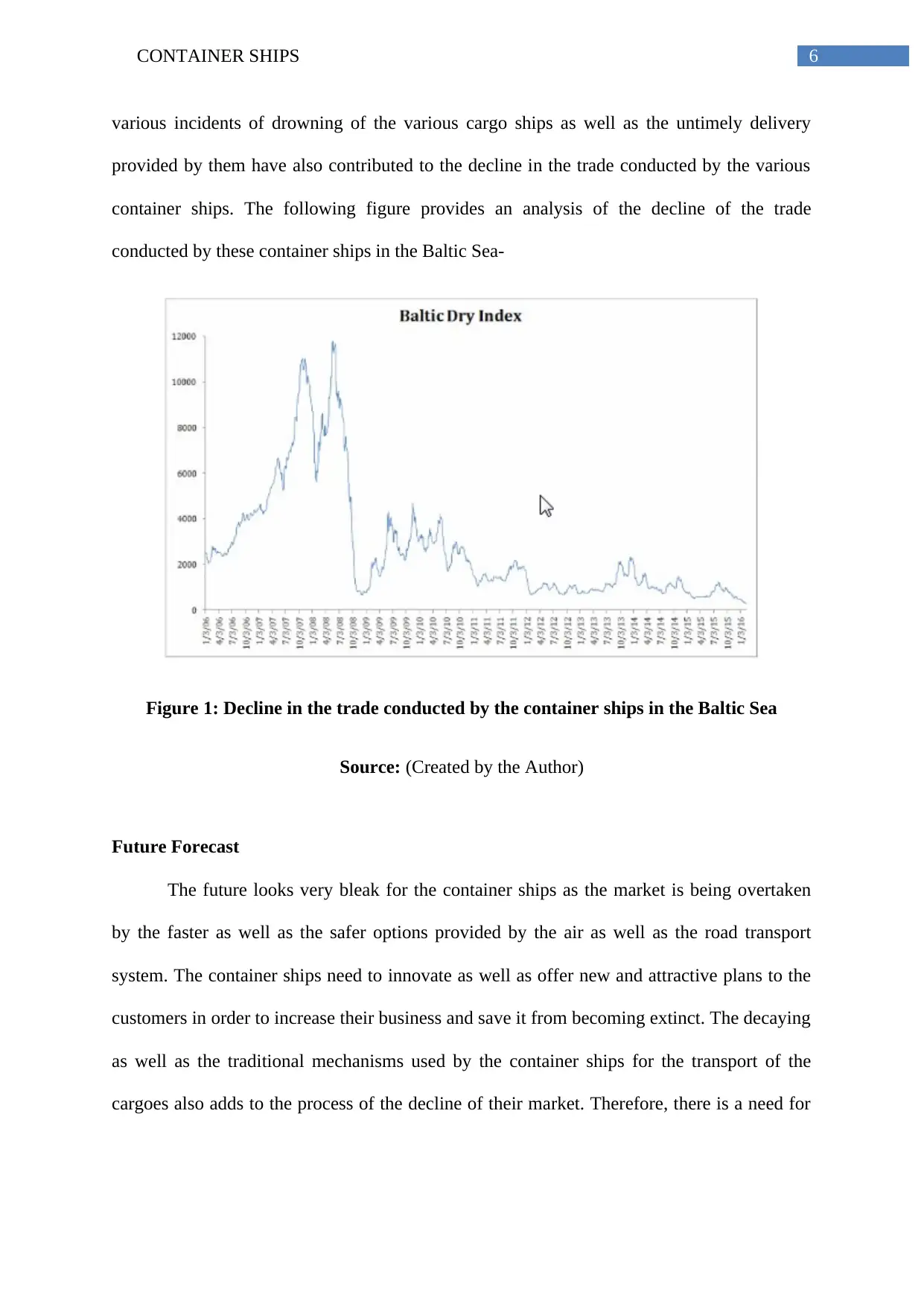
6CONTAINER SHIPS
various incidents of drowning of the various cargo ships as well as the untimely delivery
provided by them have also contributed to the decline in the trade conducted by the various
container ships. The following figure provides an analysis of the decline of the trade
conducted by these container ships in the Baltic Sea-
Figure 1: Decline in the trade conducted by the container ships in the Baltic Sea
Source: (Created by the Author)
Future Forecast
The future looks very bleak for the container ships as the market is being overtaken
by the faster as well as the safer options provided by the air as well as the road transport
system. The container ships need to innovate as well as offer new and attractive plans to the
customers in order to increase their business and save it from becoming extinct. The decaying
as well as the traditional mechanisms used by the container ships for the transport of the
cargoes also adds to the process of the decline of their market. Therefore, there is a need for
various incidents of drowning of the various cargo ships as well as the untimely delivery
provided by them have also contributed to the decline in the trade conducted by the various
container ships. The following figure provides an analysis of the decline of the trade
conducted by these container ships in the Baltic Sea-
Figure 1: Decline in the trade conducted by the container ships in the Baltic Sea
Source: (Created by the Author)
Future Forecast
The future looks very bleak for the container ships as the market is being overtaken
by the faster as well as the safer options provided by the air as well as the road transport
system. The container ships need to innovate as well as offer new and attractive plans to the
customers in order to increase their business and save it from becoming extinct. The decaying
as well as the traditional mechanisms used by the container ships for the transport of the
cargoes also adds to the process of the decline of their market. Therefore, there is a need for
Paraphrase This Document
Need a fresh take? Get an instant paraphrase of this document with our AI Paraphraser
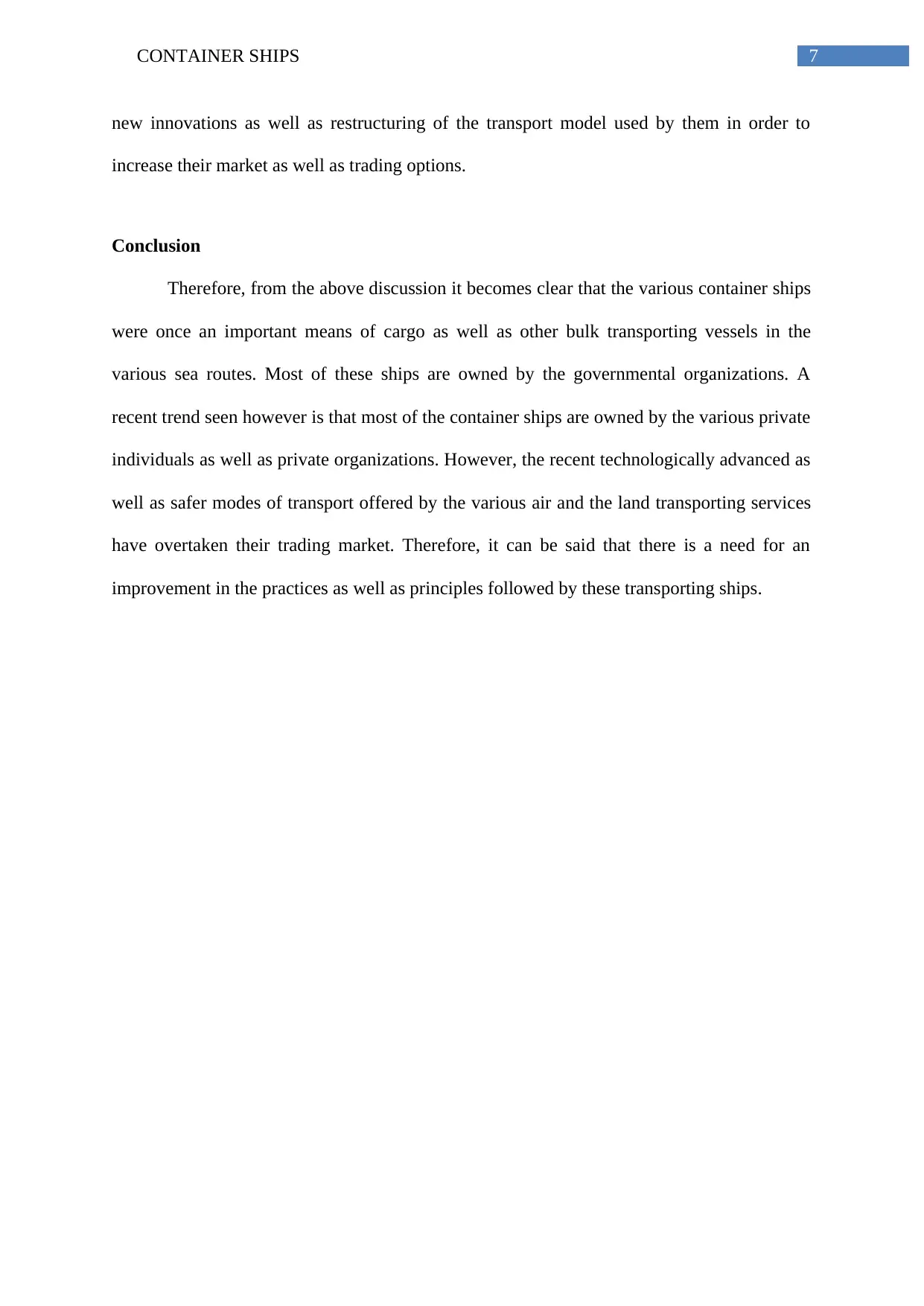
7CONTAINER SHIPS
new innovations as well as restructuring of the transport model used by them in order to
increase their market as well as trading options.
Conclusion
Therefore, from the above discussion it becomes clear that the various container ships
were once an important means of cargo as well as other bulk transporting vessels in the
various sea routes. Most of these ships are owned by the governmental organizations. A
recent trend seen however is that most of the container ships are owned by the various private
individuals as well as private organizations. However, the recent technologically advanced as
well as safer modes of transport offered by the various air and the land transporting services
have overtaken their trading market. Therefore, it can be said that there is a need for an
improvement in the practices as well as principles followed by these transporting ships.
new innovations as well as restructuring of the transport model used by them in order to
increase their market as well as trading options.
Conclusion
Therefore, from the above discussion it becomes clear that the various container ships
were once an important means of cargo as well as other bulk transporting vessels in the
various sea routes. Most of these ships are owned by the governmental organizations. A
recent trend seen however is that most of the container ships are owned by the various private
individuals as well as private organizations. However, the recent technologically advanced as
well as safer modes of transport offered by the various air and the land transporting services
have overtaken their trading market. Therefore, it can be said that there is a need for an
improvement in the practices as well as principles followed by these transporting ships.
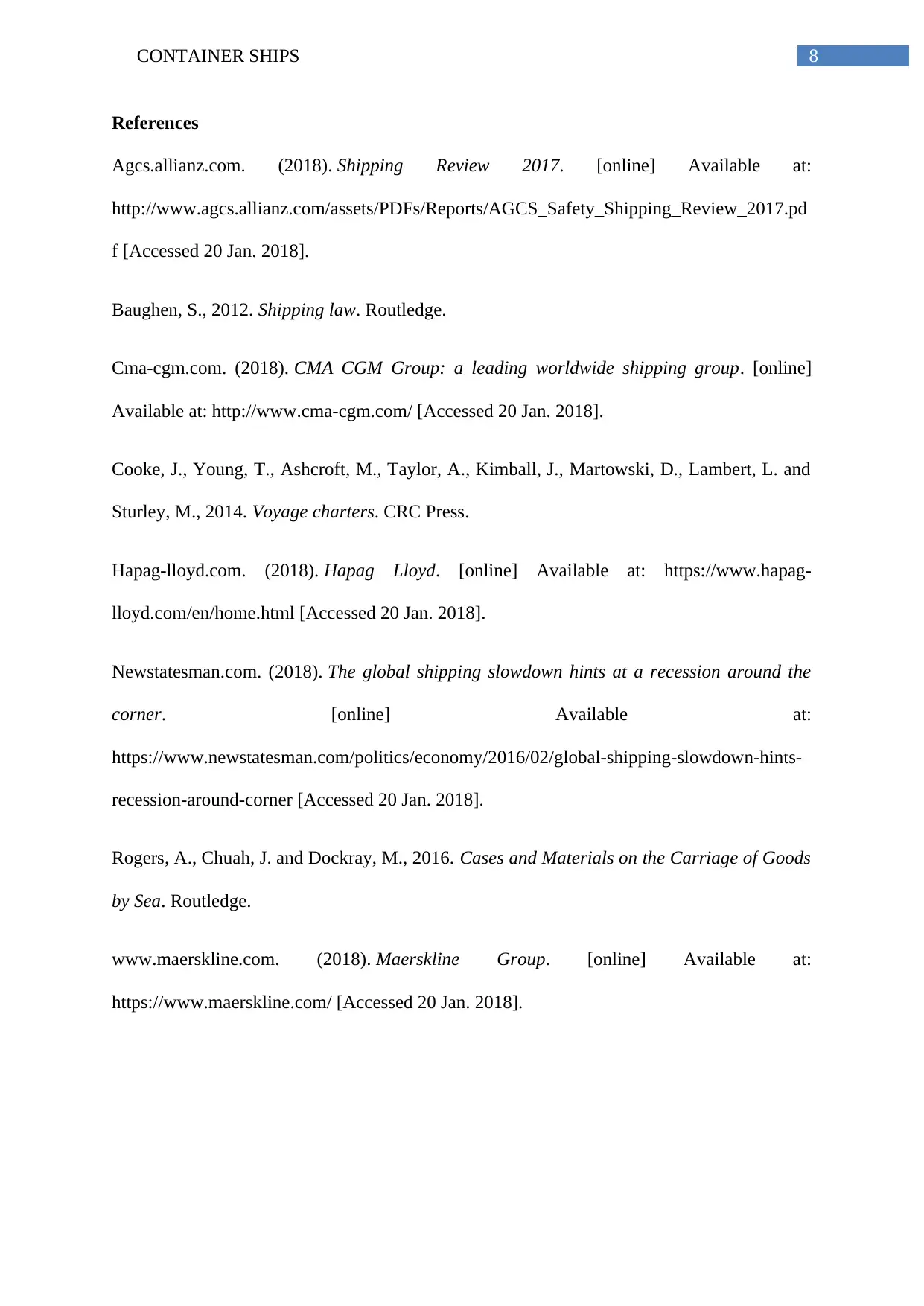
8CONTAINER SHIPS
References
Agcs.allianz.com. (2018). Shipping Review 2017. [online] Available at:
http://www.agcs.allianz.com/assets/PDFs/Reports/AGCS_Safety_Shipping_Review_2017.pd
f [Accessed 20 Jan. 2018].
Baughen, S., 2012. Shipping law. Routledge.
Cma-cgm.com. (2018). CMA CGM Group: a leading worldwide shipping group. [online]
Available at: http://www.cma-cgm.com/ [Accessed 20 Jan. 2018].
Cooke, J., Young, T., Ashcroft, M., Taylor, A., Kimball, J., Martowski, D., Lambert, L. and
Sturley, M., 2014. Voyage charters. CRC Press.
Hapag-lloyd.com. (2018). Hapag Lloyd. [online] Available at: https://www.hapag-
lloyd.com/en/home.html [Accessed 20 Jan. 2018].
Newstatesman.com. (2018). The global shipping slowdown hints at a recession around the
corner. [online] Available at:
https://www.newstatesman.com/politics/economy/2016/02/global-shipping-slowdown-hints-
recession-around-corner [Accessed 20 Jan. 2018].
Rogers, A., Chuah, J. and Dockray, M., 2016. Cases and Materials on the Carriage of Goods
by Sea. Routledge.
www.maerskline.com. (2018). Maerskline Group. [online] Available at:
https://www.maerskline.com/ [Accessed 20 Jan. 2018].
References
Agcs.allianz.com. (2018). Shipping Review 2017. [online] Available at:
http://www.agcs.allianz.com/assets/PDFs/Reports/AGCS_Safety_Shipping_Review_2017.pd
f [Accessed 20 Jan. 2018].
Baughen, S., 2012. Shipping law. Routledge.
Cma-cgm.com. (2018). CMA CGM Group: a leading worldwide shipping group. [online]
Available at: http://www.cma-cgm.com/ [Accessed 20 Jan. 2018].
Cooke, J., Young, T., Ashcroft, M., Taylor, A., Kimball, J., Martowski, D., Lambert, L. and
Sturley, M., 2014. Voyage charters. CRC Press.
Hapag-lloyd.com. (2018). Hapag Lloyd. [online] Available at: https://www.hapag-
lloyd.com/en/home.html [Accessed 20 Jan. 2018].
Newstatesman.com. (2018). The global shipping slowdown hints at a recession around the
corner. [online] Available at:
https://www.newstatesman.com/politics/economy/2016/02/global-shipping-slowdown-hints-
recession-around-corner [Accessed 20 Jan. 2018].
Rogers, A., Chuah, J. and Dockray, M., 2016. Cases and Materials on the Carriage of Goods
by Sea. Routledge.
www.maerskline.com. (2018). Maerskline Group. [online] Available at:
https://www.maerskline.com/ [Accessed 20 Jan. 2018].
⊘ This is a preview!⊘
Do you want full access?
Subscribe today to unlock all pages.

Trusted by 1+ million students worldwide
1 out of 9
Your All-in-One AI-Powered Toolkit for Academic Success.
+13062052269
info@desklib.com
Available 24*7 on WhatsApp / Email
![[object Object]](/_next/static/media/star-bottom.7253800d.svg)
Unlock your academic potential
Copyright © 2020–2025 A2Z Services. All Rights Reserved. Developed and managed by ZUCOL.

